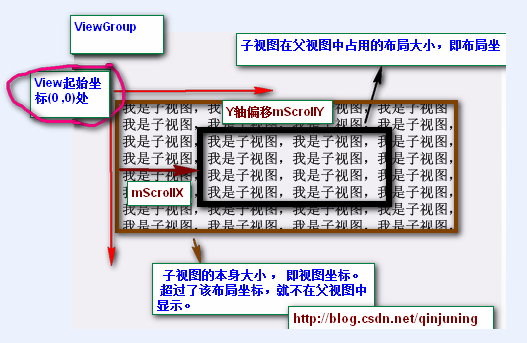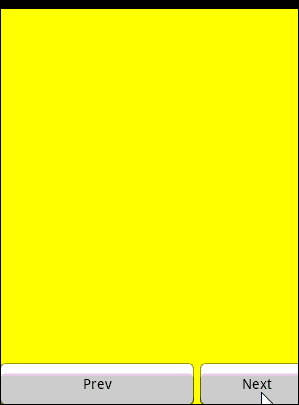Android中滑屏初探 ---- scrollTo 以及 scrollBy方法使用说明
今天给大家介绍下Android中滑屏功能的一个基本实现过程以及原理初探,最后给大家重点讲解View视图中scrollTo 与
scrollBy这两个函数的区别 。
首先 ,我们必须明白在Android View视图是没有边界的,Canvas是没有边界的,只不过我们通过绘制特定的View时对
Canvas对象进行了一定的操作,例如 : translate(平移)、clipRect(剪切)等,以便达到我们的对该Canvas对象绘制的要求 ,
我们可以将这种无边界的视图称为“视图坐标”-----它不受物理屏幕限制。通常我们所理解的一个Layout布局文件只是该视
图的显示区域,超过了这个显示区域将不能显示到父视图的区域中 ,对应的,我们可以将这种有边界的视图称为“布局坐标”
------ 父视图给子视图分配的布局(layout)大小。而且, 一个视图的在屏幕的起始坐标位于视图坐标起始处,如下图所示。
这么来说吧 ,世界本是无边无界的,可是我们的眼睛我们的心约束了我们所看到的“世界” 。
如下所示:

黑色框框表示该子视图的布局坐标, 褐色框框表示该子视图的视图坐标--该坐标是无限的,超过了父视图给子视图
规定的区域后,不再显示该超出内容。
那么下面的问题就是:如何将我们的视图的任意坐标能显示到该视图的中心坐标上呢? 由于该布局位置是只能显示特定的
一块视图内容 ,因此我们需要通过scrollTo()或者scrollBy()方法将我们期望的视图“滚动”至布局坐标上。
在View.java中提供了了如下两个变量以及相应的属性方法去读取滚动值 ,如下: View.java类中
- /**
- * The offset, in pixels, by which the content of this view is scrolled
- * horizontally.
- * {@hide}
- */
- protected int mScrollX; //该视图内容相当于视图起始坐标的偏移量 , X轴 方向
- /**
- * The offset, in pixels, by which the content of this view is scrolled
- * vertically.
- * {@hide}
- */
- protected int mScrollY; //该视图内容相当于视图起始坐标的偏移量 , Y轴方向
- /**
- * Return the scrolled left position of this view. This is the left edge of
- * the displayed part of your view. You do not need to draw any pixels
- * farther left, since those are outside of the frame of your view on
- * screen.
- *
- * @return The left edge of the displayed part of your view, in pixels.
- */
- public final int getScrollX() {
- return mScrollX;
- }
- /**
- * Return the scrolled top position of this view. This is the top edge of
- * the displayed part of your view. You do not need to draw any pixels above
- * it, since those are outside of the frame of your view on screen.
- *
- * @return The top edge of the displayed part of your view, in pixels.
- */
- public final int getScrollY() {
- return mScrollY;
- }
/**
* The offset, in pixels, by which the content of this view is scrolled
* horizontally.
* {@hide}
*/
protected int mScrollX; //该视图内容相当于视图起始坐标的偏移量 , X轴 方向
/**
* The offset, in pixels, by which the content of this view is scrolled
* vertically.
* {@hide}
*/
protected int mScrollY; //该视图内容相当于视图起始坐标的偏移量 , Y轴方向 /**
* Return the scrolled left position of this view. This is the left edge of
* the displayed part of your view. You do not need to draw any pixels
* farther left, since those are outside of the frame of your view on
* screen.
*
* @return The left edge of the displayed part of your view, in pixels.
*/
public final int getScrollX() {
return mScrollX;
} /**
* Return the scrolled top position of this view. This is the top edge of
* the displayed part of your view. You do not need to draw any pixels above
* it, since those are outside of the frame of your view on screen.
*
* @return The top edge of the displayed part of your view, in pixels.
*/
public final int getScrollY() {
return mScrollY;
}
注意,所谓的“by which the content of this view is scrolled”表示该偏移量只针对于该View中onDraw()方法里的
具体内容实现,而不针对绘制背景图片等 。具体原因可参考<Android中View绘制流程以及invalidate()等相关方法分析>
提示:下文中提到的当前视图内容是在绘制在布局坐标处的内容。
public void scrollTo(int x, int y)
说明:在当前视图内容偏移至(x , y)坐标处,即显示(可视)区域位于(x , y)坐标处。
方法原型为: View.java类中
- /**
- * Set the scrolled position of your view. This will cause a call to
- * {@link #onScrollChanged(int, int, int, int)} and the view will be
- * invalidated.
- * @param x the x position to scroll to
- * @param y the y position to scroll to
- */
- public void scrollTo(int x, int y) {
- //偏移位置发生了改变
- if (mScrollX != x || mScrollY != y) {
- int oldX = mScrollX;
- int oldY = mScrollY;
- mScrollX = x; //赋新值,保存当前便宜量
- mScrollY = y;
- //回调onScrollChanged方法
- onScrollChanged(mScrollX, mScrollY, oldX, oldY);
- if (!awakenScrollBars()) {
- invalidate(); //一般都引起重绘
- }
- }
- }
/**
* Set the scrolled position of your view. This will cause a call to
* {@link #onScrollChanged(int, int, int, int)} and the view will be
* invalidated.
* @param x the x position to scroll to
* @param y the y position to scroll to
*/
public void scrollTo(int x, int y) {
//偏移位置发生了改变
if (mScrollX != x || mScrollY != y) {
int oldX = mScrollX;
int oldY = mScrollY;
mScrollX = x; //赋新值,保存当前便宜量
mScrollY = y;
//回调onScrollChanged方法
onScrollChanged(mScrollX, mScrollY, oldX, oldY);
if (!awakenScrollBars()) {
invalidate(); //一般都引起重绘
}
}
}
public void scrollBy(int x, int y)
说明:在当前视图内容继续偏移(x , y)个单位,显示(可视)区域也跟着偏移(x,y)个单位。
方法原型为: View.java类中
- /**
- * Move the scrolled position of your view. This will cause a call to
- * {@link #onScrollChanged(int, int, int, int)} and the view will be
- * invalidated.
- * @param x the amount of pixels to scroll by horizontally
- * @param y the amount of pixels to scroll by vertically
- */
- // 看出原因了吧 。。 mScrollX 与 mScrollY 代表我们当前偏移的位置 , 在当前位置继续偏移(x ,y)个单位
- public void scrollBy(int x, int y) {
- scrollTo(mScrollX + x, mScrollY + y);
- }
/**
* Move the scrolled position of your view. This will cause a call to
* {@link #onScrollChanged(int, int, int, int)} and the view will be
* invalidated.
* @param x the amount of pixels to scroll by horizontally
* @param y the amount of pixels to scroll by vertically
*/
// 看出原因了吧 。。 mScrollX 与 mScrollY 代表我们当前偏移的位置 , 在当前位置继续偏移(x ,y)个单位
public void scrollBy(int x, int y) {
scrollTo(mScrollX + x, mScrollY + y);
}
第一个小Demo非常简单 ,大家重点理解与掌握scrollTo() 与 scrollBy()函数的用法和区别。
第二个小Demo则有了Launcher的模样,能够左右切换屏幕 。实现功能如下: 采用了一个自定义ViewGroup,该ViewGroup
对象包含了3个LinearLayout子视图,并且以一定的布局坐标(由layout()方法指定)显示在ViewGroup上。 接下来,即可调用该
ViewGroup对象的scrollTo或者scrollBy()方法切换指定视图内容了,即切换屏幕。 呵呵 ,挺好玩的吧 。
如果对View绘制流程不懂的,可以参考我的这篇博客<Android中View绘制流程以及invalidate()等相关方法分析> 。
截图如下:

自定义ViewGroup如下:
- //自定义ViewGroup , 包含了三个LinearLayout控件,存放在不同的布局位置,通过scrollBy或者scrollTo方法切换
- public class MultiViewGroup extends ViewGroup {
- private Context mContext;
- private static String TAG = "MultiViewGroup";
- public MultiViewGroup(Context context) {
- super(context);
- mContext = context;
- init();
- }
- public MultiViewGroup(Context context, AttributeSet attrs) {
- super(context, attrs);
- mContext = context;
- init();
- }
- private void init() {
- // 初始化3个 LinearLayout控件
- LinearLayout oneLL = new LinearLayout(mContext);
- oneLL.setBackgroundColor(Color.RED);
- addView(oneLL);
- LinearLayout twoLL = new LinearLayout(mContext);
- twoLL.setBackgroundColor(Color.YELLOW);
- addView(twoLL);
- LinearLayout threeLL = new LinearLayout(mContext);
- threeLL.setBackgroundColor(Color.BLUE);
- addView(threeLL);
- }
- // measure过程
- @Override
- protected void onMeasure(int widthMeasureSpec, int heightMeasureSpec) {
- Log.i(TAG, "--- start onMeasure --");
- // 设置该ViewGroup的大小
- int width = MeasureSpec.getSize(widthMeasureSpec);
- int height = MeasureSpec.getSize(heightMeasureSpec);
- setMeasuredDimension(width, height);
- int childCount = getChildCount();
- Log.i(TAG, "--- onMeasure childCount is -->" + childCount);
- for (int i = 0; i < childCount; i++) {
- View child = getChildAt(i);
- // 设置每个子视图的大小 , 即全屏
- child.measure(MultiScreenActivity.screenWidth, MultiScreenActivity.scrrenHeight);
- }
- }
- // layout过程
- @Override
- protected void onLayout(boolean changed, int l, int t, int r, int b) {
- // TODO Auto-generated method stub
- Log.i(TAG, "--- start onLayout --");
- int startLeft = 0; // 每个子视图的起始布局坐标
- int startTop = 10; // 间距设置为10px 相当于 android:marginTop= "10px"
- int childCount = getChildCount();
- Log.i(TAG, "--- onLayout childCount is -->" + childCount);
- for (int i = 0; i < childCount; i++) {
- View child = getChildAt(i);
- child.layout(startLeft, startTop,
- startLeft + MultiScreenActivity.screenWidth,
- startTop + MultiScreenActivity.scrrenHeight);
- startLeft = startLeft + MultiScreenActivity.screenWidth ; //校准每个子View的起始布局位置
- //三个子视图的在屏幕中的分布如下 [0 , 320] / [320,640] / [640,960]
- }
- }
- }
//自定义ViewGroup , 包含了三个LinearLayout控件,存放在不同的布局位置,通过scrollBy或者scrollTo方法切换
public class MultiViewGroup extends ViewGroup { private Context mContext; private static String TAG = "MultiViewGroup"; public MultiViewGroup(Context context) {
super(context);
mContext = context;
init();
} public MultiViewGroup(Context context, AttributeSet attrs) {
super(context, attrs);
mContext = context;
init();
} private void init() {
// 初始化3个 LinearLayout控件
LinearLayout oneLL = new LinearLayout(mContext);
oneLL.setBackgroundColor(Color.RED);
addView(oneLL); LinearLayout twoLL = new LinearLayout(mContext);
twoLL.setBackgroundColor(Color.YELLOW);
addView(twoLL); LinearLayout threeLL = new LinearLayout(mContext);
threeLL.setBackgroundColor(Color.BLUE);
addView(threeLL);
} // measure过程
@Override
protected void onMeasure(int widthMeasureSpec, int heightMeasureSpec) { Log.i(TAG, "--- start onMeasure --"); // 设置该ViewGroup的大小
int width = MeasureSpec.getSize(widthMeasureSpec);
int height = MeasureSpec.getSize(heightMeasureSpec);
setMeasuredDimension(width, height); int childCount = getChildCount();
Log.i(TAG, "--- onMeasure childCount is -->" + childCount);
for (int i = 0; i < childCount; i++) {
View child = getChildAt(i);
// 设置每个子视图的大小 , 即全屏
child.measure(MultiScreenActivity.screenWidth, MultiScreenActivity.scrrenHeight);
}
} // layout过程
@Override
protected void onLayout(boolean changed, int l, int t, int r, int b) {
// TODO Auto-generated method stub
Log.i(TAG, "--- start onLayout --");
int startLeft = 0; // 每个子视图的起始布局坐标
int startTop = 10; // 间距设置为10px 相当于 android:marginTop= "10px"
int childCount = getChildCount();
Log.i(TAG, "--- onLayout childCount is -->" + childCount);
for (int i = 0; i < childCount; i++) {
View child = getChildAt(i);
child.layout(startLeft, startTop,
startLeft + MultiScreenActivity.screenWidth,
startTop + MultiScreenActivity.scrrenHeight);
startLeft = startLeft + MultiScreenActivity.screenWidth ; //校准每个子View的起始布局位置
//三个子视图的在屏幕中的分布如下 [0 , 320] / [320,640] / [640,960]
}
} }
PS :大家可以分别给这几个LinearLayout试着添加几个子View,例如TextView, Button等。
至于Launcher上滑屏功能的实现,我尝试着去掌握,可能天资愚钝吧,对Scoller类很是感冒,现今还没有掌握好,不过在此
给大家推荐几个不错的学习资源 。 以后有需要的话,还是采用拿来主义吧。 囧
1、 Scoller类介绍:android 中文 api (64) —— Scroller
2、相关资源汇总:http://blog.csdn.net/dellheng/article/details/7164275
示例源代码位于: http://download.csdn.net/detail/qinjuning/4054840
Android中滑屏初探 ---- scrollTo 以及 scrollBy方法使用说明的更多相关文章
- android 布局之滑动探究 scrollTo 和 scrollBy 方法使用说明
涉及到滑动,就涉及到VIEW,大家都知道,Android的UI界面都是由一个一个的View以及View的派生类组成,View作为基类,而常用的布局里面的各种布局就是它派生出来的ViewGroup的子类 ...
- Android中滑屏实现----手把手教你如何实现触摸滑屏以及Scroller类详解
前言: 虽然本文标题的有点标题党的感觉,但无论如何,通过这篇文章的学习以及你自己的实践认知,写个简单的滑屏小 Demo还是just so so的. 友情提示: 在继续往下面读之前,希望您对以下知识点 ...
- Android中滑屏实现----触摸滑屏以及Scroller类详解 .
转:http://blog.csdn.net/qinjuning/article/details/7419207 知识点一: 关于scrollTo()和scrollBy()以及偏移坐标的设置/取值问 ...
- [学习总结]1、View的scrollTo 和 scrollBy 方法使用说明和区别
参考资料:http://blog.csdn.net/vipzjyno1/article/details/24577023 非常感谢这个兄弟! 先查看这2个方法的源码: scrollTo: 1 /** ...
- 【Android 基础】Android中全屏或者取消标题栏
先介绍去掉标题栏的方法: 第一种:也一般入门的时候经常使用的一种方法 requestWindowFeature(Window.FEATURE_NO_TITLE);//去掉标题栏 注意这句一定要写在se ...
- Android 中Activity生命周期分析:Android中横竖屏切换时的生命周期过程
最近在面试Android,今天出了一个这样的题目,即如题: 我当时以为生命周期是这样的: onCreate --> onStart -- ---> onResume ---> onP ...
- Android中全屏 取消标题栏,TabHost中设置NoTitleBar的三种方法(转)
Android中全屏 取消标题栏,TabHost中设置NoTitleBar的三种方法http://www.cnblogs.com/zdz8207/archive/2013/02/27/android- ...
- Android逆向之旅---Android中锁屏密码算法解析以及破解方案
一.前言 最近玩王者荣耀,下载了一个辅助样本,结果被锁机了,当然破解它很简单,这个后面会详细分析这个样本,但是因为这个样本引发出的欲望就是解析Android中锁屏密码算法,然后用一种高效的方式制作锁机 ...
- android中实现view可以滑动的六种方法
在android开发中,经常会遇到一个view需要它能够支持滑动的需求.今天就来总结实现其滑动的六种方法.其实每一种方法的 思路都是一样的,即:监听手势触摸的坐标来实现view坐标的变化,从而实现vi ...
随机推荐
- Spring AOP实现方式二【附源码】
自动代理模式[和我们说的方式一 配置 和 测试调用不一样哦~~~] 纯POJO切面 源码结构: 1.首先我们新建一个接口,love 谈恋爱接口. package com.spring.aop; /* ...
- bzoj3144
最小割解决最优值最突出的特点就是要将对象划分到两个集合中这题很明显,裸的最小割先把点连成一根根柱子,就是p(x,y,k)-->p(x,y,k+1)流量是P(x,y,k+1)的不和谐值然后s与p( ...
- Linux kernel AACRAID Driver Compat IOCTL 本地安全绕过漏洞
漏洞名称: Linux kernel AACRAID Driver Compat IOCTL 本地安全绕过漏洞 CNNVD编号: CNNVD-201311-390 发布时间: 2013-11-29 更 ...
- [HDU 1561] The more, The Better
The more, The Better Time Limit: 6000/2000 MS (Java/Others) Memory Limit: 32768/32768 K (Java/Oth ...
- easyui 中的treegrid添加checkbox
<script type="text/javascript"> function show(checkid){ var s = '#check_'+checkid; / ...
- 《C#并行编程高级教程》第6章 PLINQ:声明式数据并行 笔记
PLINQ这个话题好多书都写到过,这本也没有什么特别好的地方. 几个有用和有趣的点记录一下. 顺序的不确定性 用PLINQ就一定要记住并行后会导致顺序不确定的问题.解决方案就是AsOrdered或 ...
- 【转】ubuntu 12.04英文版设置成中文版
原文网址:http://blog.csdn.net/hhbgk/article/details/7958776 适用于ubuntu 12.04英文版的系统,其它版本的设置应该是大同小异的. 进入ubu ...
- js循环array,json,map
var str = '[{"uname":"王强","day":"2010/06/17"},{"uname&q ...
- SSO单点登录解决方案[转载]
1 什么是单点登陆 单点登录(Single Sign On),简称为 SSO,是目前比较流行的企业业务整合的解决方案之一.SSO的定义是在多个应用系统中,用户只需要登录一次就可以访问所有相互 ...
- Visual Studio 2010打开水晶报表是出现二进制
水晶报表在64位的机器下未安装成功 解决方法 到http://www.cnblogs.com/siyunianhua/p/4806513.html下载 水晶报表VS2010版IDE安装标准版SAP ...
